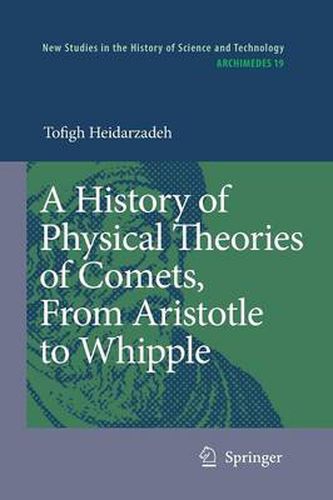Readings Newsletter
Become a Readings Member to make your shopping experience even easier.
Sign in or sign up for free!
You’re not far away from qualifying for FREE standard shipping within Australia
You’ve qualified for FREE standard shipping within Australia
The cart is loading…






This title is printed to order. This book may have been self-published. If so, we cannot guarantee the quality of the content. In the main most books will have gone through the editing process however some may not. We therefore suggest that you be aware of this before ordering this book. If in doubt check either the author or publisher’s details as we are unable to accept any returns unless they are faulty. Please contact us if you have any questions.
Although the development of ideas about the motion and trajectory of comets has been investigated piecemeal, we lack a comprehensive and detailed survey of ph- ical theories of comets. The available works either illustrate relatively short periods in the history of physical cometology or portray a landscape view without adequate details. The present study is an attempt to review - with more details - the major physical theories of comets in the past two millennia, from Aristotle to Whipple. My research, however, did not begin with antiquity. The basic question from which this project originated was a simple inquiry about the cosmic identity of comets at the dawn of the astronomical revolution: how did natural philosophers and astronomers define the nature and place of a new category of celestial objects - comets - after Brahe’s estimation of cometary distances? It was from this turning point in the history of cometary theories that I expanded my studies in both the pre-modern and modern eras. A study starting merely from Brahe and ending with Newton, without covering classical and medieval thought about comets, would be incomplete and leave the fascinating achievements of post-Newtonian cometology unexplored.
$9.00 standard shipping within Australia
FREE standard shipping within Australia for orders over $100.00
Express & International shipping calculated at checkout
This title is printed to order. This book may have been self-published. If so, we cannot guarantee the quality of the content. In the main most books will have gone through the editing process however some may not. We therefore suggest that you be aware of this before ordering this book. If in doubt check either the author or publisher’s details as we are unable to accept any returns unless they are faulty. Please contact us if you have any questions.
Although the development of ideas about the motion and trajectory of comets has been investigated piecemeal, we lack a comprehensive and detailed survey of ph- ical theories of comets. The available works either illustrate relatively short periods in the history of physical cometology or portray a landscape view without adequate details. The present study is an attempt to review - with more details - the major physical theories of comets in the past two millennia, from Aristotle to Whipple. My research, however, did not begin with antiquity. The basic question from which this project originated was a simple inquiry about the cosmic identity of comets at the dawn of the astronomical revolution: how did natural philosophers and astronomers define the nature and place of a new category of celestial objects - comets - after Brahe’s estimation of cometary distances? It was from this turning point in the history of cometary theories that I expanded my studies in both the pre-modern and modern eras. A study starting merely from Brahe and ending with Newton, without covering classical and medieval thought about comets, would be incomplete and leave the fascinating achievements of post-Newtonian cometology unexplored.